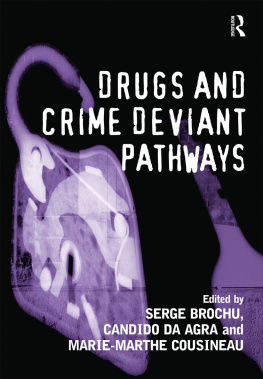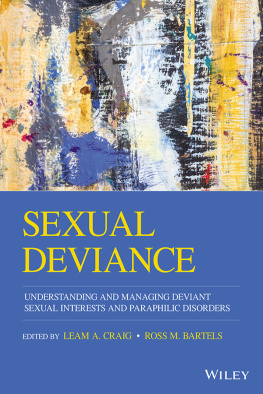DRUGS AND CRIME DEVIANT PATHWAYS
To our families
First published 2002 by Ashgate Publishing
Published 2016 by Routledge
2 Park Square, Milton Park, Abingdon, Oxon OX14 4RN
711 Third Avenue, New York, NY 10017, USA
Routledge is an imprint of the Taylor & Francis Group, an informa business
Copyright Serge Brochu, Candido da Agra and Marie-Marthe Cousineau 2002
The editors have asserted their moral right under the Copyright, Designs and Patents Act, 1988, to be identified as the editors of this work.
All rights reserved. No part of this book may be reprinted or reproduced or utilised in any form or by any electronic, mechanical, or other means, now known or hereafter invented, including photocopying and recording, or in any information storage or retrieval system, without permission in writing from the publishers.
Notice:
Product or corporate names may be trademarks or registered trademarks, and are used only for identification and explanation without intent to infringe.
British Library Cataloguing in Publication
Data Drugs and crime deviant pathways
1. Deviant behaviour 2. Drug abuse and crime 3. Criminal psychology I. Brochu, Serge II. Agra, Candido da III. Cousineau, Marie-Marthe
364.3
Library of Congress Cataloging-in-Publication Data
Drugs and crime deviant pathways I edited by Serge Brochu, Candido da Agra, and Marie-Marthe Cousineau.
p. cm.
Includes bibliographical references.
ISBN 0-7546-3023-4
1. Drug abuse and crime. 2. Criminal behaviour. I. Brochu, Serge. II. Agra, Candido da. III. Cousineau, Marie-Marthe.
HV5801 .0742 2002
364.24-dc21
2002018202
ISBN 13: 978-0-7546-3023-4 (hbk)
Contents
Serge Brochu, Candido da Agra and Marie-Marthe Cousineau
Candido da Agra
Celina Manita and Candido da Agra
Michel Kokoreff and Claude Faugeron
Lus Fernandes and Tiago Neves
Ren Carbonneau
Michel Born and Claire Gavray
Natacha Brunelle, Marie-Marthe Cousineau and Serge Brochu
Isabelle Parent and Serge Brochu
Patricia G. Erickson, Jennifer Butters and Beric German
Lisa Maher, Eloise Dunlap and Bruce D. Johnson
Helmut Kury, Joachim Obergfell-Fuchs and Theodore Ferdinand
Franoise Facy, Myriam Rabaud and Daniel Ruffin
Cline Mercier and Sophie Alarie
Marie-Marthe Cousineau, Candido da Agra and Serge Brochu
Biogram (processual interpretation grid)
Example of a biogram
Cumulative juvenile infractions (average number of infractions) up to 18th birthday
Substance use several times or often over the last year
Average score on parental authority scale
Average score on parental pleasure scale
Seriousness and incidence of criminal acts
Pathways in relation to the position in the life system and involvement in drugs
List of predictors for drug abuse by Kandel and list of predicting elements for delinquency by Leitenberg
Frequency of delinquent acts committed during last year in 1992
Comparison of replies given by males and females to questions about criminality
Similarities of predicting models for drug use and delinquency
Prevalence of delinquent acts
Deviant trajectories according to transitions in/out of delinquency in relation to specific delinquent acts
Mean score of delinquency in 1996 according to drug use in 1992
Mean score of deviance in 1996 according to the combination of two factors (social and professional trajectories and possible drug consumption in 1996)
Characteristics of consumption among delinquent users
Characteristics of delinquency among delinquent non-users and delinquent users
Nationality and work situation of the father among DNU and DU
Regression of 1992 factors on the use of drugs among persistent delinquents
Regression of 1996 factors on the use of drugs among persistent delinquents
Three sample recruitment strategies by deviant lifestyle type
Kai Pernanen
The explanation of human behaviour is a multidisciplinary task. Nowhere is this more evident than in the case of behaviour which is linked to the use of psychoactive substances. Whether it is behaviour under the influence of a drug or behaviour that is in some degree determined by dependence on drugs, it is clear that this chemical-biological component ought to be integrated into explanations using different types of psychological and environmental components.
Multidisciplinary determination means that theoretical integration is needed. However, finding a suitable conceptual and theoretical framework for this purpose is not easy, and attempts that are too ambitious can easily fail. This is nevertheless a goal that should be kept in mind while we pursue the more mundane task of describing and explaining deviant behaviour, whether or not it is linked to the use or abuse of drugs.
Looking at human behaviour as it evolves over extended periods of time introduces yet another dimension of complexity to the description and explanation of behaviour, interactions and relationships. The human organism develops and matures, environments change from school and dependence on parents to the contexts of work and other forms of intimate relationships. Structural factors change over time according to their own logics (or lack of such). In the lives of young people who are not protected by a healthy family life the orderly developmental progression is often disrupted and structural and environmental factors such as economic conditions and the policies of social authorities can have more profound consequences.
Despite the complexities of studying the development of life courses and the factors that influence aspects of these courses, the task is intuitively appealing even to the non-scientist. People do structure their lives in terms of pathways; they recognize, especially in hindsight, significant life events and junctions where decisions were made that had far-reaching consequences for the course of ones life (sometimes without realizing the significance of the decision or the occurrence at the time). People are known to muse over the course that their own and other peoples lives have taken or could have taken: where did I go wrong, if it hadnt been for .... Individuals who are at high risk of deviating from central societal norms are no different in many of the types of influences that affect them and their attempts to make sense of these occurrences and their own reactions, although their plans and objective prospects are often restricted by both environmental and individual psychological factors.
Charting and explaining the course of a life or segments of lives is therefore something that comes naturally. Surprisingly, this preoccupation has not found a systematic and prominent counterpart in the study of deviant behaviour (nor in studies of human behaviour generally). The framework of deviant pathways promises to become a significant aid in this systematization. It promises to bring together disparate elements of theory, method and empirical findings.
Drug use is strongly associated with other forms of deviance in many cultures. An important challenge for pathway analysis is to lay bare the processes by which this occurs. There will no doubt be somewhat different answers for different countries and jurisdictions. Some of these answers may surprise us.












